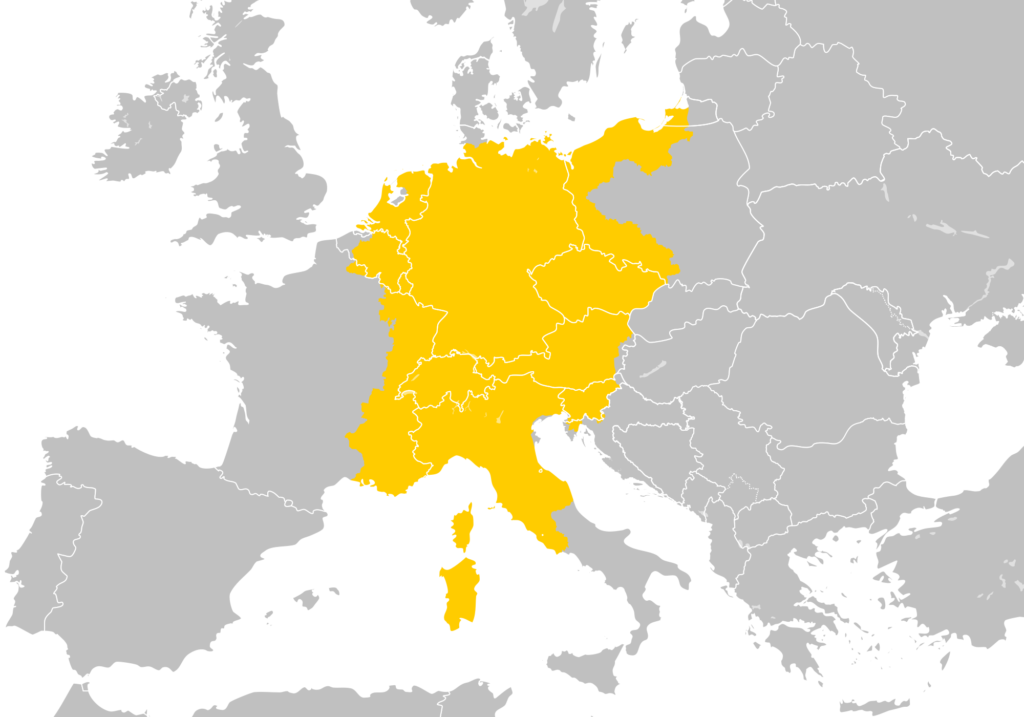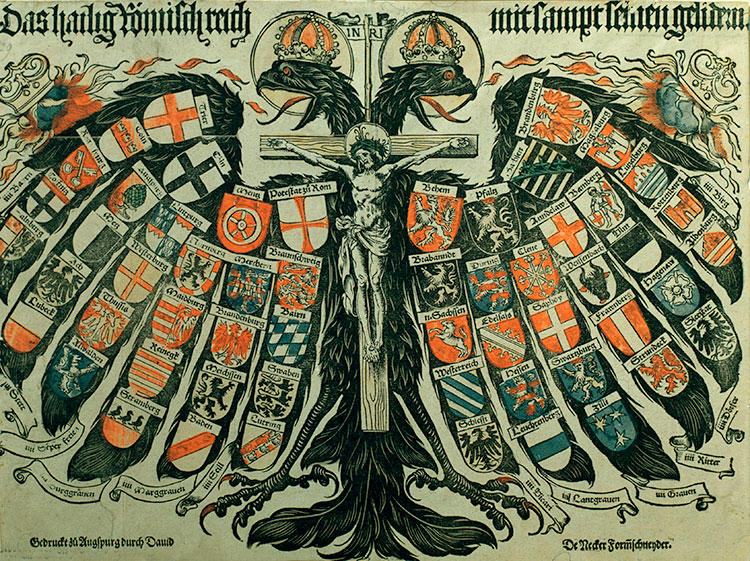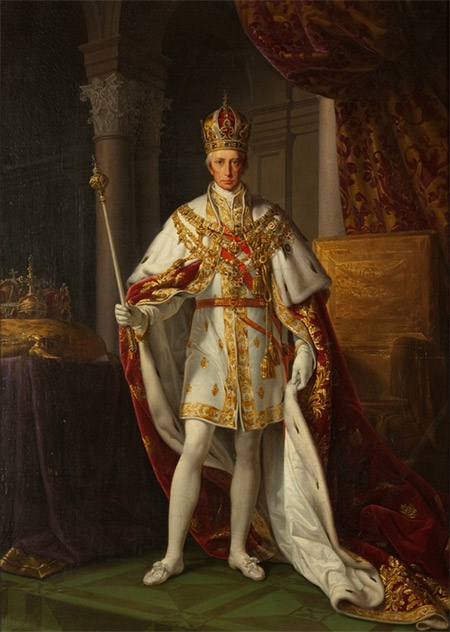The Holy Roman Empire was a large collection of thousands of political entities of many different ethnicities that existed for more than a thousand years at the heart of Europe. Stretching from modern-day Italy to Denmark, from France to Poland. The Holy Roman Empire was an important part of European history, with several countries that exist today having emerged from the Empire. Keeping in line with the Empire’s complex nature, there isn’t even a universally agreed upon date as to when the Empire actually ‘started’. The two dates that are cited are 800 and 962 AD.
Holy Roman Empire: Part 1

After the fall of the Western Roman Empire in the 5th century, the Roman Empire was reduced to its eastern half. Of course, their capital was no longer Rome, it was the ethnically Greek city of Constantinople. Now, while the inhabitants of this empire continued to see themselves as, well, the Roman Empire, modern historians tend to refer to them as the Byzantine Empire, based on the old name for the capital city, Byzantium. Anyway, 3 centuries later the Frankish king Charlemagne has crowned “Emperor of the Romans”, as the Pope transferred the imperial title from the east back to the west.
At the time, the title was considered “vacant” because it was held by a woman, known simply as “Irene”, who killed her own son to take power from him… The Frankish Kingdoms were split and reunited several times, with 3 kingdoms emerging that would make up the core of the Holy Roman Empire: the German Kingdom, the Italian Kingdom, and the Burgundian Kingdom. There was also The Kingdom of Bohemia, but that didn’t become a kingdom until 1198. In 961, Otto I, king of Germany, came to the assistance of Pope John XII as the Papal States were invaded by Berengar II of Italy.
Otto conquered northern Italy and deposed Berengar as his own troops abandoned him. The Pope crowned Otto emperor in 962, the first German to be emperor. Almost all successors would also be German for the rest of the Empire’s existence. The early years of the Empire’s history are dominated by its strained relations with the Papacy. A seemingly never-ending the power struggle between various emperors and popes over the course of several centuries. They could never agree who was superior: Pope or Emperor.
In the mid 13th century, the empire had an “Interregnum”, in which no king has crowned Emperor for 67 years. This would actually be the first of three interregnums, as another two times in the next century and a half would see long stretches of time without a crowned emperor. During the rule of Charles IV, the Golden Bull of 1356 saw some major changes to the Empire. Seven fixed electors were chosen who would decide the King of Germany, which had become a symbolic title of the elected but yet-to-be coronated emperor.
Holy Roman Empire: Part 2
In 1440, with the election of Frederick III as Emperor, this began three straight centuries of emperors from the same royal family: the House of Habsburg, from Austria. During the reign of Maximilian I, the Habsburgs greatly expanded their influence through political marriages, acquiring Burgundy, Spain, Bohemia, and Hungary. In 1494, war broke out on the Italian Peninsula, primarily between the Habsburgs and France, over disagreements about various territories and their respective inheritance, most notably: Milan, Naples, and Sicily.
The war would continue on and off for more than 60 years and effectively ended imperial rule in Italy. In 1517, Martin Luther from Saxony published his 95 Theses, criticizing the Roman Catholic Church and many of its practices, in what became known as the Protestant Reformation, profoundly changing the course of European history. The Holy Roman Empire became divided, as many of the Emperor’s subjects adopted Lutheranism, creating religious tensions that would last for more than a century, and to an extent, even to this day.
It was around this difficult time that probably the most well-known Holy Roman Emperor began his rule: Charles V. Charles was already king of Spain, so the Habsburgs’ power reached its peak with a vast array of territories both in and out of the Empire. His rule was dominated by religious conflict. First starting with a war against various Lutheran princely estates known as the Schmalkaldic League, who were defeated by Charles and several Catholic princes. The Peace of Augsburg in 1555 gave rulers the right to choose the religion of their estate: Catholicism or Lutheranism, based on the principle of “Cuius regio, eius religion”.
Shortly afterward, Charles V abdicated, splitting his inheritance between Spain and Austria. His son Philip II succeeded him in Spain, while his younger brother Ferdinand took over as Emperor and Archduke of Austria, starting the cadet branch of the House of Habsburg. Religious tensions continued as a rebellion started in the Spanish Netherlands, eventually leading to the establishment of the Dutch Republic, with seven of the seventeen provinces seceding from Spain and the Empire. In 1618, the Thirty Years War started in Bohemia with the Defenestration of Prague, which is just a fancy way of saying “throwing someone out of a window”.
Holy Roman Empire: Part 3
In this case, four Catholic lords. This began the Bohemian Revolt, which spiraled into a continent-wide power struggle with all major European powers involved. The war ended with the Peace of Westphalia, a massive turning point in the Empire’s history. Many view this as the beginning of the end of the Holy Roman Empire. Dutch independence was finally officially recognized, as well as the independence of Switzerland and the territories in northern Italy. The Empire became even more decentralized, and the Habsburgs’ power began to decline.
After the Peace of Westphalia, it becomes less relevant to talk about the history of the Holy Roman Empire as a whole, because what happened in the last 150 years of the Empire’s existence relates more to the princely estates as individual entities in their own right. There were several very important and impactful wars through the late 17th and early 18th centuries, such as the Franco-Dutch War, the Nine Years War, and the War of the Spanish Succession, there were always imperial princes on both sides of these conflicts.
There was also the Long Turkish War, but that was more related to the Habsburgs and their possessions, given that much of the fighting was over Hungary, which was never part of the Empire. The final years of the Empire were dominated by the rivalry between Austria and Prussia, by far the two most dominant German powers. Austria had a succession crisis and the Habsburgs’ three centuries of ruling the Empire came to a temporary end as Charles VII of Bavaria took over until 1745. The two powers clashed in the global conflict the Seven Years War over Silesia, as France and Austria unsuccessfully tried to curb the rising Prussian power.
The Holy Roman Empire came to end at the hands of Napoleon and revolutionary France. Austria was invaded in 1792, and renewed tensions in 1806 caused the last Emperor Francis II to officially dissolve the Empire, ending just over one thousand years of existence. Now writing an about the Holy Roman Empire, I am of course legally obligated to mention the Voltaire quote that it was neither Holy, nor Roman, nor an Empire. It’s important to look at the context though, Voltaire lived throughout the 1700s, when the Empire was very much in decline.
Holy Roman Empire: Part 4
He was also French, and part of the Enlightenment movement, so he understandably took a somewhat negative view of the Empire, viewing it as something of a ‘relic’ of the past, that had no place in modern society. So just how true is his statement? Well, although the term “Holy” wasn’t used until some 350 years after its creation, the holy element was absolutely essential for the empire to function. Its primary purpose was to provide a stable political order for all Christians. The Emperor was supposed to be the guardian of the Pope, and defend his subjects against infidels.
At the time, the thought of secular power was inconceivable without any reference to divine authority. In practice, of course, the various emperors and popes throughout the years had somewhat strained relations, and the papacy became less and less involved in the empire’s politics as the years went on. The term “Holy Empire” was first used in 1157 by the ruling Stauffer family, who tried to shift the emphasis from a monarch to a transpersonal holy empire that had already sanctified its divine mission, and therefore the empire did not need approval from the pope.
So in effect, the addition of the word “holy” was actually an attempt to distance the empire from the papacy. Now “Roman”… that’s a little bit more tricky. It may seem obvious to some that it was quite clearly not Roman, it was German. It’s pretty clear that it was not a direct continuation of the Roman Empire… and even if it was, it wouldn’t have revived the Western Roman Empire that actually had Rome as its capital, but rather, it would have inherited its “Roman-ness” from the now Greek Eastern Roman Empire when the title of Emperor was transferred from Constantinople back to Rome.
The divide between the Latin West and the Greek East had been growing stronger over a preceding couple of centuries. Charlemagne was crowned in the year 800 with a somewhat tenuous link to the ancient Roman Empire. The prestige and authority commanded by the title Roman Emperor still held a lot of weight in the West, and Charlemagne was recognized as Emperor, giving him immense power and status. People at the time really did view the Empire as a direct continuation from ancient Rome.
Holy Roman Empire: Part 5
Frankish rule over Italy didn’t begin until 774, and although the Franks had been Christianised, and even somewhat Romanised, they didn’t want to completely lose their own identity. As the years went on, of course, it became much less Roman and much more German. After a few centuries, most emperors didn’t even travel south of the Alps in their entire reign, expect to be crowned by the pope… and even that was discontinued after Charles V. The word Empire doesn’t really have a universally agreed upon definition so it’s not really possible to definitively say that it was or it wasn’t an empire.
The idea of an emperor was that he was a monarch above that of a king, a sort of “king of kings”. Now according to the divine mandate, the Roman Empire was to be the last and greatest empire, and there could only be one. The idea of an empire was singular and universal. This the idea of singularity was deeply rooted in Christian thought at the time, empires could not co-exist. This was based on the theory of “translation imperii”, the pretext used by the pope to transfer authority from Constantinople. For most of its history, the Holy Roman Empire was referred to as simply “the Empire”, without any qualifiers, even in official documents.
There were no other empires that were recognized in the West for most of its history. The Holy Roman Empire wasn’t just “an” empire… it was THE Empire. Whether or not it could be classed as an empire by today’s standard is debatable, the Empire was quite decentralized, and many of the regional princes commanded much more power in their territory than the emperor did. The Holy Roman Empire is quite a unique political entity, there’s not really much else that is comparable. The Holy Roman Empire used a complex system of feudalism to rule over its many territories.
The local authority was delegated to vassals, who would normally in-turn have their own vassals, creating a hierarchy of lords and vassals who swore allegiance to each other. Lords would protect their vassals, and vassals would help and advise their lords, and often pay them in cash, work, or military assistance. Now vassals could either be immediate or mediate vassals. Immediate vassals were those that were immediately subordinate to the emperor, while mediate vassals had at least one overlord between themselves and the emperor.
Holy Roman Empire: Part 6
Immediate vassals of the emperor were referred to as imperial princes, and their territories were imperial estates. Imperial estates could pay a general tax to the empire to take part in the Imperial Diet, or the Reichstag. Those who did not pay the tax were not involved in decisions and had no vote. After 1489, the imperial estates were divided into three separate “chambers”, or “colleges”: prince electors, imperial princes, and imperial cities. There were also the imperial knights that were immediate vassals to the emperor but not represented.
Counts and other nobles did not have a vote despite their immediacy status, although they were grouped into “benches” that had a collective vote. The prince-electors were considered of a higher status than that of the other princes. The prince-electors had the important task of electing the Emperor. For most of the empire’s history, there were 7 prince-electors: 3 ecclesiastical electors, and 4 secular electors. The elective the process quickly became corrupt and the imperial the title was pretty much just gained via bribery.
In the year 1500, the Empire was divided into six “imperial circles”. The circles were created to better organize the Empire’s defensive structures as well as to facilitate tax collection. In 1512, a further 3 were added, and Saxony was divided into two. There were areas that were not part of any imperial circle, most notably Bohemia, plus the Swiss and Italian parts of the empire. Now, unfortunately, due to its complexity, it’s impossible to represent the hierarchy of the Holy Roman Empire with a neat little pyramid with the Emperor at the top.
There was no single chain of command, and many of the internal hierarchies were interconnected. Imperial princes could have the same political status as each other but with different prestige based on their noble title, such as king, duke, count, and so on. The most powerful imperial estate for centuries, Austria, actually created their own title: Archduke. Brandenburg-Prussia became a kingdom in 1701, but for the first 71 years, their kings were titled “King in Prussia” as opposed to King of Prussia, because Prussia fell outside the territory of the Empire and therefore did not require imperial authorization.
Holy Roman Empire: Part 7
Prussia was well on its way to becoming a great power in its own right, so really there was nothing the Empire could do to stop them anyway. At the start of the article, I mentioned that the Holy Roman Empire was comprised of the three core kingdoms: Germany, Italy, and Burgundy. Plus Bohemia, but that’s a little different. So who was the King of Germany? And how did this title play into the hierarchy of the Empire? Well, the King of Germany, Italy, and Burgundy were 3 separate titles, but in practice, for most of the Empire’s history, all 3 of these titles were held by the same person, who was usually the emperor as well.
This wasn’t always the case, and in the earlier years it was more complicated, but generally speaking, it was one person who held all titles. In practice, the specific titles largely fell out of use as they had basically become synonymous with the Emperor. Bohemia was its own autonomous kingdom, being elevated from a Duchy in 1198. The Bohemian Crown Lands came under Habsburg rule from the 15th century onwards, with some gaps, so many of the Bohemian kings were, in fact, Emperor simultaneously.
The Holy Roman Empire lasted for just over a thousand years and oversaw Central Europe’s transformation from a feudal, agrarian, and religiously uniform region to an increasingly centralized, urban, and religiously divergent one. While the Holy Roman Empire was a significant power for a large part of its history, it didn’t seem able to survive the changes in European society that eventually rendered it obsolete.
The Holy Roman Empire has dissolved just over two centuries ago, but here’s an interesting thought: what would the world look like if the Empire existed today. What if the Holy Roman Empire was somehow resurrected?

